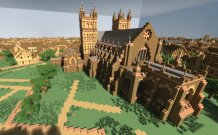
Four maps of Exeter will be built for people to download for free and use while playing Minecraft.
Experience sights of ancient Exeter using virtual reality
People can step back in time and experience what it would have been like to live among the crowded streets of Georgian Exeter thanks to virtual reality.
The city’s rich history – and the treasures at the Royal Albert Memorial Museum – are now part of the hugely popular and addictive Minecraft game.
Four maps of Exeter inspired by the RAMM’s collections will be built for people to download for free and use while playing Minecraft. The first, available now, is based on the model of 18th-century Exeter when the city walls still stood. The three future maps will be of Exeter in Roman and Tudor times.
Minecraft is like a form of virtual Lego and has fans of all ages. Players build towns or cities together in virtual groups and complete buildings by selecting blocks with different textures and uses. They can also download existing buildings, or whole conurbations and change them and add to them.
This project is part of the doctoral investigation of Sofia Romualdo, a researcher at the University of Exeter, who is working to incorporate the use of video games into the way the exhibits of the Royal Albert Memorial Museum can be viewed and experienced by the public.
YouTube stars will celebrate Exeter’s new role in Minecraft by hosting a building battle in the city this week. The Minecraft Museum Day will be held on Sunday 16 July. Young YouTubers, Solly the Kid and Django Moses, will challenge visitors to a special Exeter Build Battle where they try to build as much as possible within a set time. Wizard Keen from Wonderquest and guest YouTubers will lead workshops.
The first map is of the Hedgeland model, which was constructed between 1817 and 1824 by Caleb Hedgeland and is one of the earliest surviving models of any town in Britain. It records Exeter as it was during the late 1700s when the city wall was still intact. The model is the only surviving record of many of the city’s buildings and streets. It is on permanent display in RAMM’s Making History gallery.
Sofia said: “The beauty of this new map of Exeter is that it allows people to explore real places in different ways. The Hedgeland map and model are currently enjoyed by thousands of people, but are behind glass. People love to spot places still recognisable today, and Minecraft allows them to use the map in ways that are fun and educational.
“People can use the map as it is, they can add to it, and even destroy it. We hope to add text boxes to the maps we produce in the future so people can read information about Exeter and the museum’s objects as they play Minecraft.
“We are making visible something which has been lost. The brilliant thing is, although the model is 200 years old, everyone who lives in Exeter will be able to find parts of the city they recognise.
The Hedgeland map and model were made because Exeter was changing rapidly and important buildings and other features were being demolished. The aim was to capture parts of the city about to be lost forever.
The new Exeter maps have been made by renowned digital producer Adam Clarke and the leading Minecraft build team, Blockworks. For more information and to download the maps visit the website.
Date: 12 July 2017
